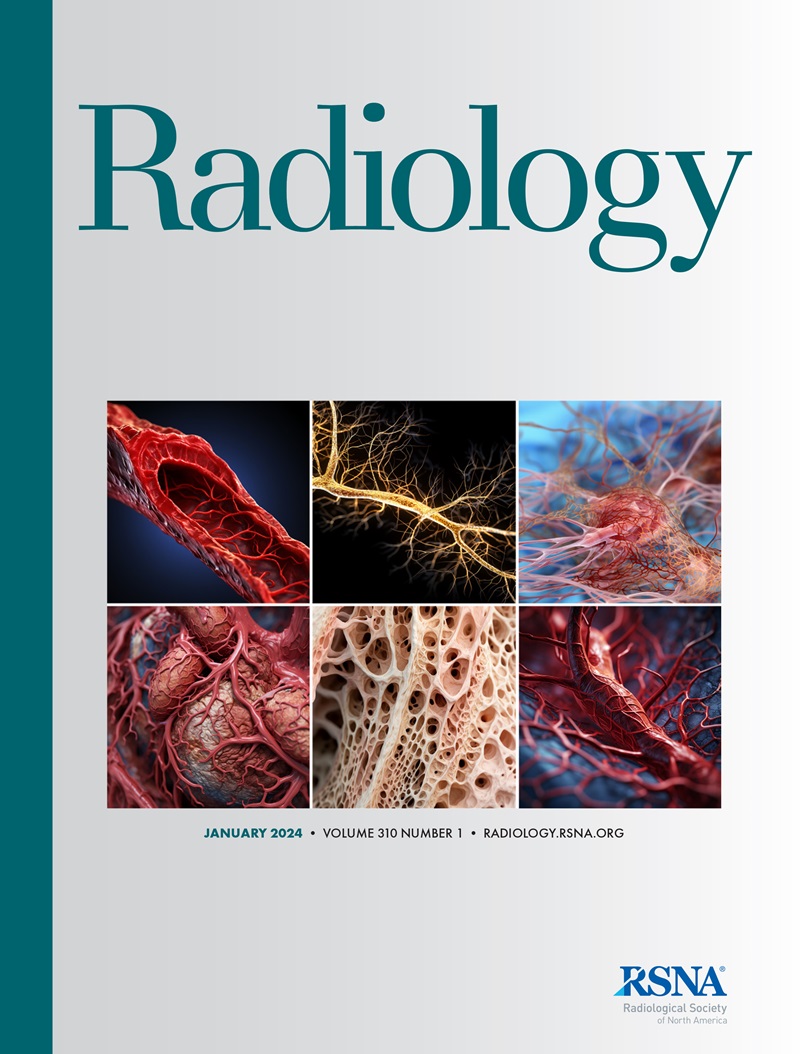Yu Shen, Xiaoling Gong, Yazhou He, Wenjian Meng, Hanjiang Zeng, Mingtian Wei, Meng Qiu, Ziqiang Wang
求助PDF
{"title":"MRI Tumor Regression Response to Neoadjuvant Chemotherapy Alone without Radiation for Rectal Adenocarcinoma.","authors":"Yu Shen, Xiaoling Gong, Yazhou He, Wenjian Meng, Hanjiang Zeng, Mingtian Wei, Meng Qiu, Ziqiang Wang","doi":"10.1148/radiol.232908","DOIUrl":null,"url":null,"abstract":"<p><p>Background Neoadjuvant chemotherapy (NCT) is gaining acceptance for the management of locally advanced rectal cancer (LARC) in patients without negative prognostic factors. However, the value of MRI in evaluating tumor response after NCT remains unclear. Purpose To investigate the accuracy of MRI in assessing pathologic complete response in participants with LARC who underwent surgery after NCT without radiation. Materials and Methods A retrospective imaging substudy was conducted within two consecutive prospective clinical trials: the expanded phase II trial (from December 2017 to May 2021) and the COPEC trial (comparison of tumor response to two or four cycles of neoadjuvant chemotherapy alone, ongoing from August 2021). All included participants received four cycles of capecitabine combined with oxaliplatin (or CAPOX) before surgery. Three radiologists who were blinded to the clinicopathologic data independently evaluated the tumor response using five methods, namely, MR tumor regression grade (MR-TRG) alone, diffusion-weighted imaging (DWI) alone, DWI-modified MR-TRG (DWImodMR-TRG), MRI complete response, and radiologic neoadjuvant response score. With pathologic assessment serving as the reference standard, the positive and negative predictive values, sensitivity, specificity, and area under the receiver operating characteristic curve (AUC) were determined to evaluate the accuracy and performance of these models. The AUCs of the models were compared using the DeLong test. Results A total of 224 participants were included, comprising 119 from the expanded phase II trial (median age, 61 years [IQR, 53-67]; 89 male) and 105 from the COPEC trial (median age, 59 years [IQR, 53-67]; 65 male). MR-TRG, DWI, DWImodMR-TRG, MRI complete response, and the radiologic neoadjuvant response score were associated with pathologic complete response. DWImodMR-TRG achieved the highest AUC of 0.90 (95% CI: 0.85, 0.95), with a specificity of 89% (162 of 182) and a negative predictive value of 93% (162 of 174). Conclusion MRI-based models were accurate for determining pathologic complete response in participants with LARC following NCT. DWI improved the predictive performance of MRI-based assessment. © RSNA, 2024 <i>Supplemental material is available for this article.</i> See also the editorial by Santiago and Shur in this issue.</p>","PeriodicalId":20896,"journal":{"name":"Radiology","volume":null,"pages":null},"PeriodicalIF":12.1000,"publicationDate":"2024-08-01","publicationTypes":"Journal Article","fieldsOfStudy":null,"isOpenAccess":false,"openAccessPdf":"","citationCount":"0","resultStr":null,"platform":"Semanticscholar","paperid":null,"PeriodicalName":"Radiology","FirstCategoryId":"3","ListUrlMain":"https://doi.org/10.1148/radiol.232908","RegionNum":1,"RegionCategory":"医学","ArticlePicture":[],"TitleCN":null,"AbstractTextCN":null,"PMCID":null,"EPubDate":"","PubModel":"","JCR":"Q1","JCRName":"RADIOLOGY, NUCLEAR MEDICINE & MEDICAL IMAGING","Score":null,"Total":0}
引用次数: 0
引用
批量引用
Abstract
Background Neoadjuvant chemotherapy (NCT) is gaining acceptance for the management of locally advanced rectal cancer (LARC) in patients without negative prognostic factors. However, the value of MRI in evaluating tumor response after NCT remains unclear. Purpose To investigate the accuracy of MRI in assessing pathologic complete response in participants with LARC who underwent surgery after NCT without radiation. Materials and Methods A retrospective imaging substudy was conducted within two consecutive prospective clinical trials: the expanded phase II trial (from December 2017 to May 2021) and the COPEC trial (comparison of tumor response to two or four cycles of neoadjuvant chemotherapy alone, ongoing from August 2021). All included participants received four cycles of capecitabine combined with oxaliplatin (or CAPOX) before surgery. Three radiologists who were blinded to the clinicopathologic data independently evaluated the tumor response using five methods, namely, MR tumor regression grade (MR-TRG) alone, diffusion-weighted imaging (DWI) alone, DWI-modified MR-TRG (DWImodMR-TRG), MRI complete response, and radiologic neoadjuvant response score. With pathologic assessment serving as the reference standard, the positive and negative predictive values, sensitivity, specificity, and area under the receiver operating characteristic curve (AUC) were determined to evaluate the accuracy and performance of these models. The AUCs of the models were compared using the DeLong test. Results A total of 224 participants were included, comprising 119 from the expanded phase II trial (median age, 61 years [IQR, 53-67]; 89 male) and 105 from the COPEC trial (median age, 59 years [IQR, 53-67]; 65 male). MR-TRG, DWI, DWImodMR-TRG, MRI complete response, and the radiologic neoadjuvant response score were associated with pathologic complete response. DWImodMR-TRG achieved the highest AUC of 0.90 (95% CI: 0.85, 0.95), with a specificity of 89% (162 of 182) and a negative predictive value of 93% (162 of 174). Conclusion MRI-based models were accurate for determining pathologic complete response in participants with LARC following NCT. DWI improved the predictive performance of MRI-based assessment. © RSNA, 2024 Supplemental material is available for this article. See also the editorial by Santiago and Shur in this issue.

 求助内容:
求助内容: 应助结果提醒方式:
应助结果提醒方式:


